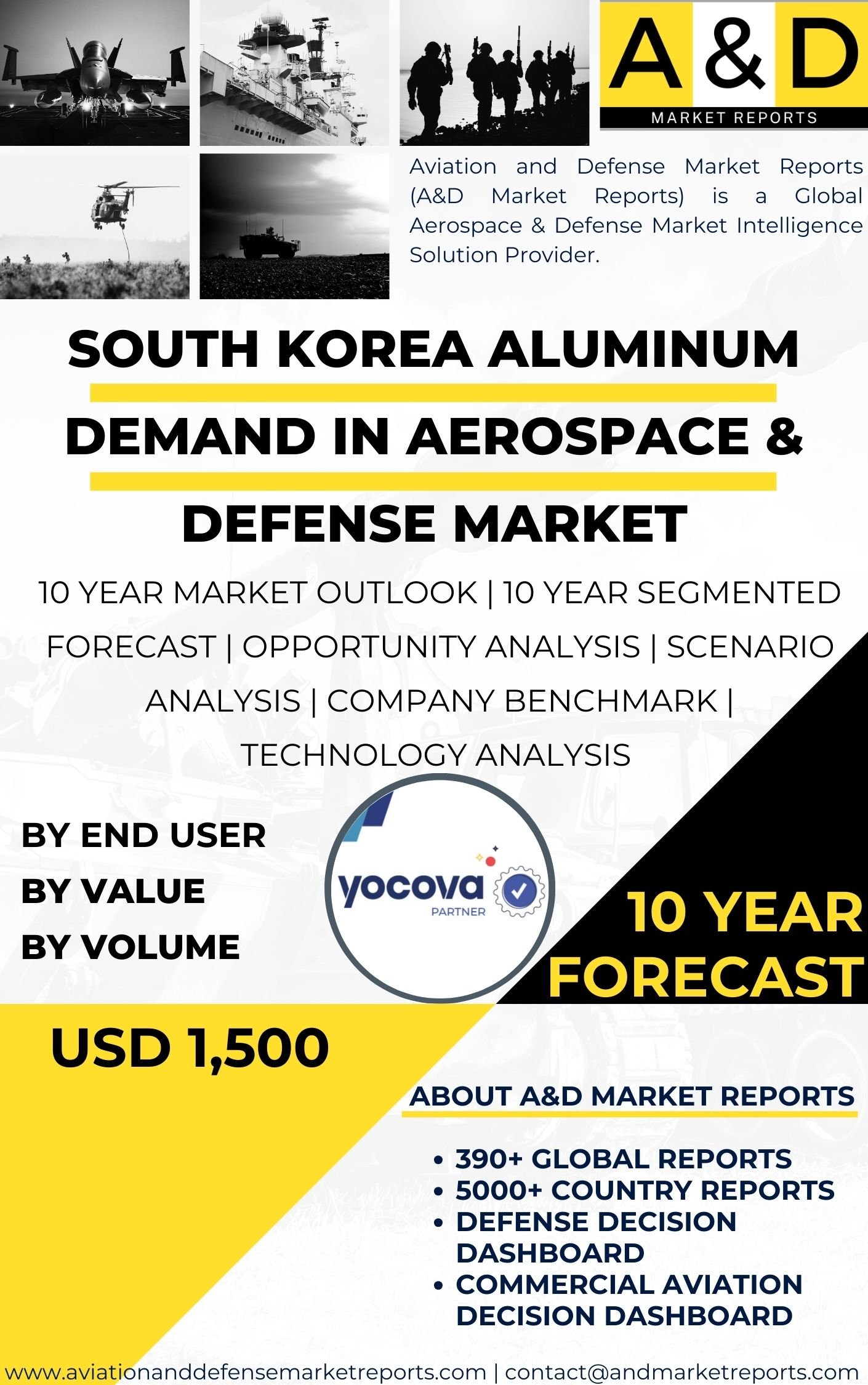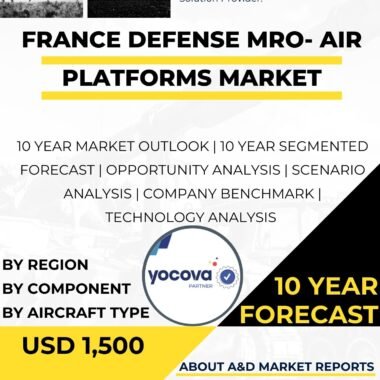Description
Aluminum Demand in South Korea Aerospace and Defense Industry Overview
The Aluminum demand in Aerospace is rising steadily. This growth reflects the country’s focus on stronger military capabilities and advanced aerospace production. Aluminum is widely used because it is lightweight, strong, and durable.
Defense platforms depend on aluminum for aircraft, armored vehicles, and weapons. Its properties support high performance and long service life.
Role of Aluminum in Aerospace and Defense Applications
Aluminum plays a key role in aerospace structures. Aircraft frames use aluminum to reduce weight and improve fuel efficiency. Lighter platforms also deliver better speed and maneuverability.
In defense systems, aluminum supports armored vehicles and naval platforms. Its corrosion resistance helps equipment perform well in harsh environments.
Technological Self-Reliance Driving Aluminum Demand
The aluminum demand in South Korea aerospace and defense industry is closely tied to self-reliance goals. South Korea is developing its own fighter jets and unmanned aerial vehicles. These programs rely heavily on aluminum-based structures.
Domestic production strengthens supply security. It also encourages innovation in aerospace manufacturing.
Defense Modernization and Material Requirements
Military modernization programs further boost aluminum usage. South Korea continues to upgrade land, air, and naval assets. These upgrades require materials that balance strength and low weight.
Aluminum improves protection while maintaining mobility. This balance is critical for modern defense operations.
International Collaboration and Manufacturing Activity
South Korea participates in defense cooperation with partner nations. These programs involve component and subassembly production. Aluminum is often the material of choice due to its versatility.
Such manufacturing activity increases demand across the supply chain. It also supports export-oriented aerospace production.
Advancements in Aluminum Research and Development
Research and development investments enhance aluminum performance. New alloy formulations meet strict aerospace and defense standards. Improved manufacturing methods raise quality and consistency.
These advances support domestic sourcing. They also reduce dependence on external materials.
Future Outlook for Aluminum Demand in South Korea Aerospace and Defense Industry
The aluminum demand in South Korea aerospace and defense industry will continue to grow. Ongoing modernization, aircraft development, and material innovation will sustain demand. Aluminum will remain essential for strengthening defense readiness and aerospace capability.
Table of content
Table Of Contents
1 Market Introduction
1.1 Market Introduction
1.2 Market Definition
1.3 Market Segmentation
1.4 10 Year Market Outlook
2 Market Technologies
3 Global Market Forecast
3.1 Global Market Forecast
3.2 By Component
3.3 By End User
4 APAC Market Trends & Forecast
4.1 Drivers, Restraints And Challenges
4.2 PEST
4.3 Market Forecast
4.3.1 Market Forecast By Component
4.3.2 Market Forecast By End User
4.4 Scenario Analysis
4.5 Key Companies& Profiling
5 South Korea Analysis
5.1 Current Levels Of Technology Maturation In This Market
5.2 Market Forecast
5.2.1 Market Forecast By Component
5.2.2 Market Forecast By End User
5.3 Scenario Analysis
5.4 Country Defense Budget (Historical and 10- year forecast)
5.5 Defense Budget Category Spending- 10- year forecast
5.6 Procurement Analysis
5.7 EXIM Data
5.8 Patents
6 Opportunity Matrix
6.1 By Component
6.2 By End User
7 Scenario Analysis
7.1 Scenario 1
7.1.1 By Component (Scenario-1)
7.1.2 By End User(Scenario-1)
7.2 Scenario 2
7.2.1 By Component (Scenario-2)
7.2.2 By End User(Scenario-2)
8 Company Benchmark
9 Strategic Conclusions
10 About Aviation And Defense Market Reports
Segments
By Component
By End Users
List of Tables
Table1: Global Market Forecast, Aluminum demand in Aerospace & Defense Industry
Table2: APAC Market Forecast, Aluminum demand in Aerospace & Defense Industry
Table3: APAC Market Forecast, By Component
Table4: APAC Market Forecast, By End Users
Table5: APAC, Scenario Analysis
Table6: South Korea Market Forecast, Aluminum demand in Aerospace & Defense Industry
Table7: South Korea Market Forecast, By Component
Table8: South Korea Market Forecast, By End Users
Table9: South Korea, Scenario Analysis
Table 10: South Korea Defense Budget 10 Year Forecast
Table 11: South Korea, Defense Budget Category Spending- 10- year forecast
Table 12: South Korea, Procurement Analysis
Table 13: South Korea, EXIM Data Analysis
Table 14: South Korea, Opportunity Analysis, By Component
Table 15: South Korea, Opportunity Analysis, By End Users
Table 16: South Korea, Scenario Analysis, By Component
Table 17: South Korea, Scenario Analysis, By End Users
Figure 1: Market Segmentation, South Korea Aluminum demand in Aerospace & Defense Industry
Figure 2: Key Technology Analysis, Aluminum demand in Aerospace & Defense Industry
Figure 3: Global Market Forecast, Aluminum demand in Aerospace & Defense Industry
Figure 4: APAC, Market Forecast, Aluminum demand in Aerospace & Defense Industry
Figure 5: APAC, Market Forecast, By Component
Figure 6: APAC, Market Forecast, By End Users
Figure 7: APAC, Scenario Analysis
Figure 8: South Korea, Market Forecast, Aluminum demand in Aerospace & Defense Industry
Figure 9: South Korea, Market Forecast, By Component
Figure 10: South Korea, Market Forecast, By End Users
Figure 11: South Korea, Scenario Analysis
Figure 12: South Korea, Defense Budget 10 Year Forecast
Figure 13: South Korea, Defense Budget Category Spending- 10- year forecast
Figure 14: South Korea, Procurement Analysis
Figure 15: South Korea, EXIM Data Analysis
Figure 16: South Korea, Opportunity Analysis, By Component
Figure 17: South Korea, Opportunity Analysis, By End Users
Figure 18: South Korea, Scenario Analysis, By Component
Figure 19: South Korea, Scenario Analysis, By End Users
Figure 20: Company Benchmark




